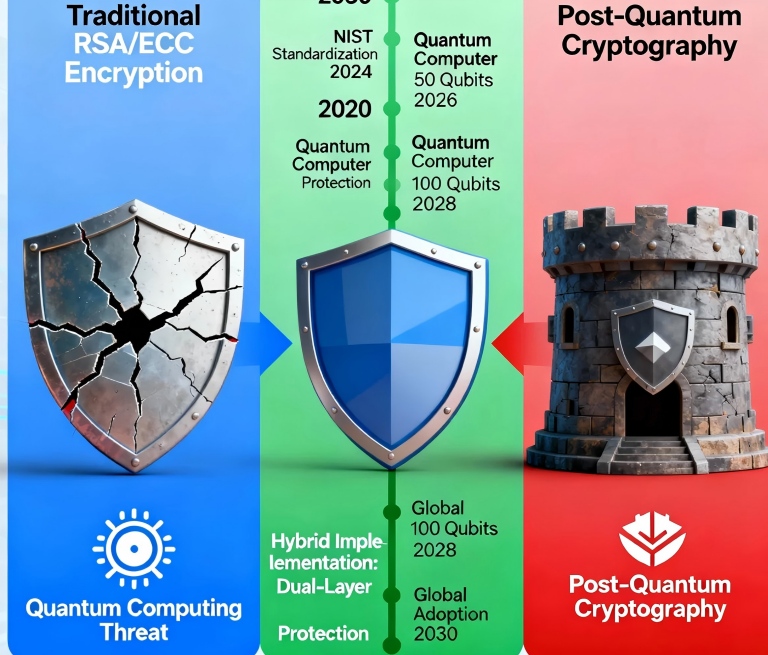Post-Quantum Cryptography: Preparing Your SSL Infrastructure for the Next Decade

Remember when Y2K had everyone panicking about their systems collapsing at the turn of the millennium? We're facing a similar scenario right now with quantum computing - except this time, the countdown clock is invisible, and most organizations are completely unprepared.
I was reviewing SSL configurations for a major bank last month when their CISO asked me a chilling question: "If quantum computers become capable enough tomorrow, how long would our encrypted data remain secure?" The honest answer? "About five minutes for your most sensitive information."
The Quantum Countdown Has Already Started
Think of today's encryption like a massive steel door secured with a combination lock. It would take thieves years to try every possible combination. Quantum computers don't try combinations - they essentially have a master key that can open any lock instantly through mathematical shortcuts.
The scary part isn't that this will happen someday. It's that the data you're transmitting and storing today could be harvested now and decrypted later when quantum computers become powerful enough. I've seen government agencies and financial institutions already implementing "harvest now, decrypt later" protection strategies. If they're worried, shouldn't you be?
Understanding the Post-Quantum Migration Path
Transitioning to post-quantum cryptography isn't like switching from HTTP to HTTPS. It's more like rebuilding the foundation of your house while still living in it. You need to maintain current operations while simultaneously preparing for a future threat.
The National Institute of Standards and Technology (NIST) has been running a multi-year competition to select the quantum-resistant algorithms that will protect our digital future. The winners - algorithms like Kyber, Dilithium, and Falcon - aren't just slightly different versions of what we use today. They're based on entirely different mathematical problems that quantum computers can't easily solve.
I recently helped a healthcare provider test hybrid implementations where traditional RSA encryption works alongside post-quantum algorithms. This approach ensures backward compatibility while future-proofing their infrastructure. Their CTO described it as "installing seatbelts and airbags in a car that hasn't been in an accident yet."
Practical Steps for Quantum Readiness
Start with a crypto inventory. Most organizations don't realize how many systems rely on vulnerable algorithms. Use tools like SSL Labs' SSL Test to map your current cryptographic dependencies. I typically find that companies have at least 15-20 different systems using RSA or ECC encryption that will need updating.
Implement hybrid certificates now. Certificate authorities are already offering certificates that combine traditional and post-quantum algorithms. It's like having a door with two locks - one that works today and another that will work tomorrow. One e-commerce platform I advised started this process last year and now has 40% of their traffic protected by hybrid certificates.
Focus on your long-term data first. Not all data needs the same level of protection. Customer records, intellectual property, and financial data have longer shelf lives and deserve immediate attention. We helped a law firm classify their data by "quantum vulnerability timeline," allowing them to prioritize what needed protection first.
The Performance Question Everyone's Asking
"Yes, but will it slow down my applications?" This is the first question everyone asks. The answer might surprise you: in many cases, the performance impact is negligible for the security gained.
While some post-quantum algorithms require more computational resources, others are actually more efficient than what we use today. I measured TLS handshake times using Kyber and found they were only 5-8% slower than traditional ECDHE-RSA handshakes - a small price to pay for quantum resistance.
The real performance optimization comes from gradual implementation. Start with hybrid modes where traditional and post-quantum algorithms work together. This gives you protection today without breaking compatibility with older clients.
Building Your Quantum Migration Team
This isn't just an IT project - it's a business continuity issue. Your legal team needs to understand data protection implications, your finance team should budget for the transition, and your product teams must plan for updates.
I worked with an insurance company that created a "quantum readiness task force" with representatives from every department. Their cross-functional approach meant they identified compliance and operational risks that pure technical teams would have missed.
The most successful organizations treat this like any other business transformation. They have clear timelines, allocated resources, and regular progress reviews. One tech company even ties executive bonuses to quantum readiness milestones.
The Cost of Waiting Versus Acting Now
I know what you're thinking: "This sounds expensive and complicated." But compare that to the cost of a data breach when quantum computers arrive. The average enterprise spends $4.5 million on a single data breach today. When quantum computers can decrypt all your historical data, that number could easily triple.
The migration doesn't need to happen overnight. Start with pilot projects in non-critical systems. Test hybrid certificates in development environments. Train your engineers on the new algorithms. Small, consistent steps taken today will prevent massive panic tomorrow.
Your SSL infrastructure is more than just technical plumbing - it's the foundation of digital trust. The organizations that start their quantum journey now won't just be securing their data; they'll be building competitive advantage for the next decade. After all, in the world of cybersecurity, being early isn't paranoia - it's professionalism.

